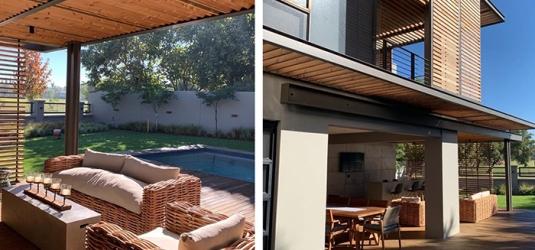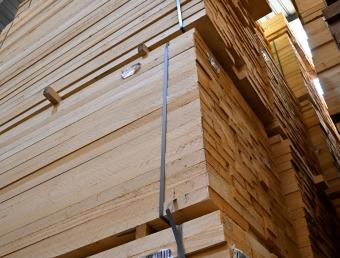
The main doubts about heat-treated wood, resolved here
03/12/2023
Does heat-treated wood resist damage caused by xylophages and woodworm?
According to studies (Militz 2002), Lunawood® heat-treated wood is resistant to some types of woodworm, such as Hylotrupes bajulus, Lyctus brunneus, and Annobium punctatum (furniture woodworm). The number of terpenes, which is observed in heat-treated wood, has decreased significantly compared to untreated wood, which may mean that woodworm prefers to lay its eggs in wood that is not heat-treated. (Source: ThermoWood handbook® from the heat-treated wood producer's association) Regarding termites, according to the results of tests carried out so far, heat-treated wood is not resistant to termites. Nunes et al. (2004) studied the resistance to termite of the species Reticulitermes grassei with heat-treated wood and concluded that the differences were not significant.
In terms of prevention, the first measure we must adopt is to prevent the wood from entering contact with the ground. There are different methods to manage termite problems, such as polyethylene films, which are installed in the building foundation and various bituminous paint products are available to block potential termite pathways into the building. However, local testing is recommended because termite types vary by region.
Does heat-treated wood make color changes?
It must be borne in mind that wood is a natural material, and each piece is different and according to each piece it takes on a slightly different tone, just as each piece has knots with different sizes or different shapes. This gives the wood its authentic and natural beauty. In any case, there are not usually very different colors within the same class. If you want to change the color of the heat-treated wood in its final use, you can apply pigmented oils and stains with different shades. You can also paint the wood with opaque paints.
Could stain be applied to heat-treated wood?
Yes, the same stains can be applied as for wood without heat treatment. Heat-treated wood can be treated with water- and solvent-based surface treatments. However, the exception is linseed oil, which is not recommended for treating heat-treated wood (forming a breeding ground for fungi).
How does woodwork in marine environments? Does it maintain its durability?
The advantage with heat-treated wood in these very humid environments is that its equilibrium moisture content does not rise more than 14% and thus its durability and dimensional stability are also maintained in these environments. This wood exposed to the external saline environment has a degradation like other environments, not from salts. However, it is recommended to apply surface treatment to protect heat treated wood against moisture, erosion, and UV radiation when under climatic stress. This is recommended for applications in a hot, humid climate.
What is the cause of black mold on wood, in rainy areas?
As with all materials exposed to natural conditions, the appearance of mold can also occur on the surface of (heat-treated) wood. Due to bacteria and impurities in the air or dirt spread by rain, mold growth can form on the surface of the wood. However, it is only on the surface and can be removed by cleaning or scratching.
Is there a way to control the color change in wood on facades where the sun can shine in different ways?
It would be very difficult (it could almost be said impossible) to control the color change when the exposure to the sun and rain of each facade is different. Over time the color becomes homogenized but at first there would be differences between the color / tone of each facade. The simpler and straighter the facade, the more homogeneous the color.
In climates such as the Mediterranean, with humidity and sun, does the wood of turns gray, cracks, or dries out?
Like all wood products, LunaThermo-D will turn gray when exposed to UV rays, and may show some fine cracks or splits on the surface over time and in hot and humid areas surface mold may appear. The "silver" effect will be visible in a relatively short period of time, 3 to 6 months after installation (depending on sun exposure). Lunawood has good durability and does not require surface treatment if the greyish hue is allowed.
How do you install heat-treated wood in the floor next to a pool, if it cannot be in contact with him?
Heat treated wood should not be in direct contact with the ground. In the case of a terrace or deck next to a pool, the heat-treated wood slats are installed on a wooden or metal / aluminum sub-structure.
According to studies (Militz 2002), Lunawood® heat-treated wood is resistant to some types of woodworm, such as Hylotrupes bajulus, Lyctus brunneus, and Annobium punctatum (furniture woodworm). The number of terpenes, which is observed in heat-treated wood, has decreased significantly compared to untreated wood, which may mean that woodworm prefers to lay its eggs in wood that is not heat-treated. (Source: ThermoWood handbook® from the heat-treated wood producer's association) Regarding termites, according to the results of tests carried out so far, heat-treated wood is not resistant to termites. Nunes et al. (2004) studied the resistance to termite of the species Reticulitermes grassei with heat-treated wood and concluded that the differences were not significant.
In terms of prevention, the first measure we must adopt is to prevent the wood from entering contact with the ground. There are different methods to manage termite problems, such as polyethylene films, which are installed in the building foundation and various bituminous paint products are available to block potential termite pathways into the building. However, local testing is recommended because termite types vary by region.
Does heat-treated wood make color changes?
It must be borne in mind that wood is a natural material, and each piece is different and according to each piece it takes on a slightly different tone, just as each piece has knots with different sizes or different shapes. This gives the wood its authentic and natural beauty. In any case, there are not usually very different colors within the same class. If you want to change the color of the heat-treated wood in its final use, you can apply pigmented oils and stains with different shades. You can also paint the wood with opaque paints.
Could stain be applied to heat-treated wood?
Yes, the same stains can be applied as for wood without heat treatment. Heat-treated wood can be treated with water- and solvent-based surface treatments. However, the exception is linseed oil, which is not recommended for treating heat-treated wood (forming a breeding ground for fungi).
How does woodwork in marine environments? Does it maintain its durability?
The advantage with heat-treated wood in these very humid environments is that its equilibrium moisture content does not rise more than 14% and thus its durability and dimensional stability are also maintained in these environments. This wood exposed to the external saline environment has a degradation like other environments, not from salts. However, it is recommended to apply surface treatment to protect heat treated wood against moisture, erosion, and UV radiation when under climatic stress. This is recommended for applications in a hot, humid climate.
What is the cause of black mold on wood, in rainy areas?
As with all materials exposed to natural conditions, the appearance of mold can also occur on the surface of (heat-treated) wood. Due to bacteria and impurities in the air or dirt spread by rain, mold growth can form on the surface of the wood. However, it is only on the surface and can be removed by cleaning or scratching.
Is there a way to control the color change in wood on facades where the sun can shine in different ways?
It would be very difficult (it could almost be said impossible) to control the color change when the exposure to the sun and rain of each facade is different. Over time the color becomes homogenized but at first there would be differences between the color / tone of each facade. The simpler and straighter the facade, the more homogeneous the color.
In climates such as the Mediterranean, with humidity and sun, does the wood of turns gray, cracks, or dries out?
Like all wood products, LunaThermo-D will turn gray when exposed to UV rays, and may show some fine cracks or splits on the surface over time and in hot and humid areas surface mold may appear. The "silver" effect will be visible in a relatively short period of time, 3 to 6 months after installation (depending on sun exposure). Lunawood has good durability and does not require surface treatment if the greyish hue is allowed.
How do you install heat-treated wood in the floor next to a pool, if it cannot be in contact with him?
Heat treated wood should not be in direct contact with the ground. In the case of a terrace or deck next to a pool, the heat-treated wood slats are installed on a wooden or metal / aluminum sub-structure.


